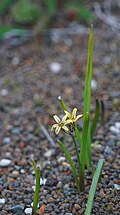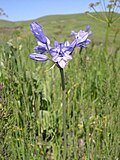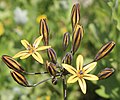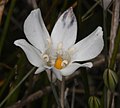
Asparagales is an order of plants in modern classification systems such as the Angiosperm Phylogeny Group (APG) and the Angiosperm Phylogeny Web. The order takes its name from the type family Asparagaceae and is placed in the monocots amongst the lilioid monocots. The order has only recently been recognized in classification systems. It was first put forward by Huber in 1977 and later taken up in the Dahlgren system of 1985 and then the APG in 1998, 2003 and 2009. Before this, many of its families were assigned to the old order Liliales, a very large order containing almost all monocots with colorful tepals and lacking starch in their endosperm. DNA sequence analysis indicated that many of the taxa previously included in Liliales should actually be redistributed over three orders, Liliales, Asparagales, and Dioscoreales. The boundaries of the Asparagales and of its families have undergone a series of changes in recent years; future research may lead to further changes and ultimately greater stability. In the APG circumscription, Asparagales is the largest order of monocots with 14 families, 1,122 genera, and about 36,000 species.

The Brassicales are an order of flowering plants, belonging to the eurosids II group of dicotyledons under the APG II system. One character common to many members of the order is the production of glucosinolate compounds. Most systems of classification have included this order, although sometimes under the name Capparales.
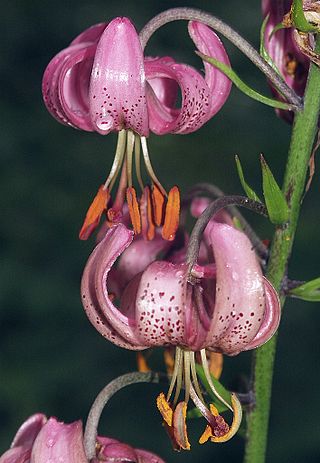
Liliales is an order of monocotyledonous flowering plants in the Angiosperm Phylogeny Group and Angiosperm Phylogeny Web system, within the lilioid monocots. This order of necessity includes the family Liliaceae. The APG III system (2009) places this order in the monocot clade. In APG III, the family Luzuriagaceae is combined with the family Alstroemeriaceae and the family Petermanniaceae is recognized. Both the order Lililiales and the family Liliaceae have had a widely disputed history, with the circumscription varying greatly from one taxonomist to another. Previous members of this order, which at one stage included most monocots with conspicuous tepals and lacking starch in the endosperm are now distributed over three orders, Liliales, Dioscoreales and Asparagales, using predominantly molecular phylogenetics. The newly delimited Liliales is monophyletic, with ten families. Well known plants from the order include Lilium (lily), tulip, the North American wildflower Trillium, and greenbrier.
Urticales is an order of flowering plants. Before molecular phylogenetics became an important part of plant taxonomy, Urticales was recognized in many, perhaps even most, systems of plant classification, with some variations in circumscription. Among these is the Cronquist system (1981), which placed the order in the subclass Hamamelidae [sic], as comprising:

Agapanthus is a genus of plants, the only one in the subfamily Agapanthoideae of the family Amaryllidaceae. The family is in the monocot order Asparagales. The name is derived from Greek: ἀγάπη, ἄνθος.

The genus Androstephium is a group of North American plants in the cluster lily subfamily within the asparagus family. It contains two species native to the southwestern and south-central United States.

Brodiaea, also known by the common name cluster-lilies, is a monocot genus of flowering plants.

The Ulmaceae are a family of flowering plants that includes the elms, and the zelkovas. Members of the family are widely distributed throughout the north temperate zone, and have a scattered distribution elsewhere except for Australasia.

Brodiaeoideae are a monocot subfamily of flowering plants in the family Asparagaceae, order Asparagales. They have been treated as a separate family, Themidaceae. They are native to Central America and western North America, from British Columbia to Guatemala. The name of the subfamily is based on the type genus Brodiaea.

Hemerocallidoideae is the a subfamily of flowering plants, part of the family Asphodelaceae sensu lato in the monocot order Asparagales according to the APG system of 2016. Earlier classification systems treated the group as a separate family, the Hemerocallidaceae. The name is derived from the generic name of the type genus, Hemerocallis. The largest genera in the group are Dianella, Hemerocallis (15), and Caesia (11).

Scilloideae is a subfamily of bulbous plants within the family Asparagaceae. Scilloideae is sometimes treated as a separate family Hyacinthaceae, named after the genus Hyacinthus. Scilloideae or Hyacinthaceae include many familiar garden plants such as Hyacinthus (hyacinths), Hyacinthoides (bluebells), Muscari and Scilla and Puschkinia. Some are important as cut flowers.
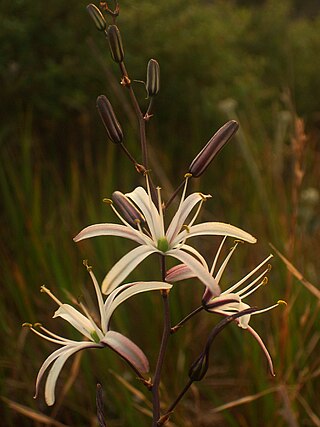
The common names soap plant, soaproot and amole refer to the genus Chlorogalum. They are native to western North America, with some species in Oregon but they are mostly found in California. Common names of the genus and several species derive from their use as soap.

Asphodelaceae is a family of flowering plants in the order Asparagales. Such a family has been recognized by most taxonomists, but the circumscription has varied widely. In its current circumscription in the APG IV system, it includes about 40 genera and 900 known species. The type genus is Asphodelus.
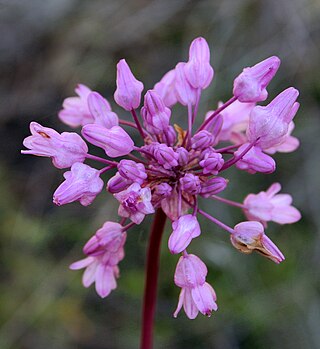
Dichelostemma is a genus of North American plants closely related to the genus Brodiaea and sometimes regarded as part of that group.

Asparagaceae, known as the asparagus family, is a family of flowering plants, placed in the order Asparagales of the monocots. The family name is based on the edible garden asparagus, Asparagus officinalis. This family includes both common garden plants as well as common houseplants. The garden plants include asparagus, yucca, bluebell, and hosta, and the houseplants include snake plant, corn cane, spider plant, and plumosus fern.
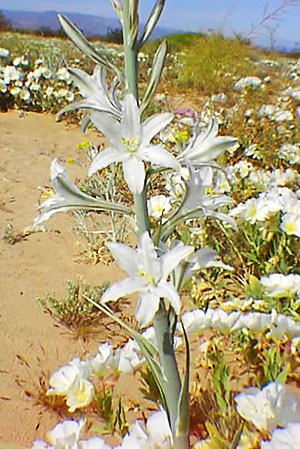
Hesperocallis is a genus of flowering plants that includes a single species, Hesperocallis undulata, known as the desert lily or ajo lily.

Bloomeria is a genus of flowering plants with a geophyte lifestyle in the family Asparagaceae, subfamily Brodiaeoideae. It was named for Hiram Green Bloomer (1819–1874) an early San Francisco botanist.
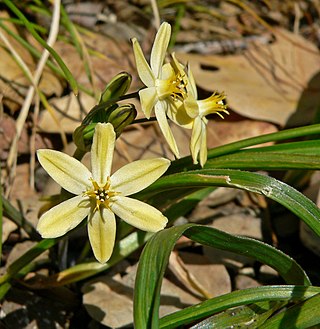
Triteleia ixioides, known as prettyface or golden star, is a monocotyledon flowering plant in the genus Triteleia. It is native to northern and central California and southwestern Oregon, where it can be found in coastal and inland coniferous forests and other habitat. It is a perennial wildflower growing from a corm. It produces one to two basal leaves up to 50 centimeters long by 1.5 wide. The inflorescence arises on an erect stem up to 80 centimeters tall. It is an umbel-like cluster of several flowers each borne on a pedicel up to 7 centimeters long. The flowers are variable in size, measuring one to nearly three centimeters in length. They are pale to bright yellow, or sometimes purple-tinged white. There are six tepals with darker midveins in shades of green, brown, or purple. The lobes are funnel-shaped and may open flat or somewhat reflexed. The six stamens form a fused tube that protrudes from the corolla; they have broad, flat filaments and whitish, yellowish, or blue anthers.

Lilioid monocots is an informal name used for a grade of five monocot orders in which the majority of species have flowers with relatively large, coloured tepals. This characteristic is similar to that found in lilies ("lily-like"). Petaloid monocots refers to the flowers having tepals which all resemble petals (petaloid). The taxonomic terms Lilianae or Liliiflorae have also been applied to this assemblage at various times. From the early nineteenth century many of the species in this group of plants were put into a very broadly defined family, Liliaceae sensu lato or s.l.. These classification systems are still found in many books and other sources. Within the monocots the Liliaceae s.l. were distinguished from the Glumaceae.

Allioideae is a subfamily of monocot flowering plants in the family Amaryllidaceae, order Asparagales. It was formerly treated as a separate family, Alliaceae. The subfamily name is derived from the generic name of the type genus, Allium. It is composed of about 18 genera.




